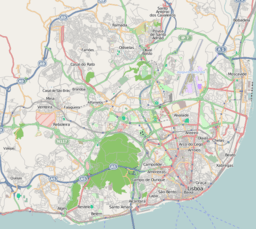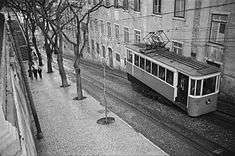Ascensor da Glória
| Glória Funicular (Ascensor da Glória) | |
| Funicular (Funicular/Ascensor/Elevador) | |
| The tram car descending to the lower station | |
| Official name: Ascensor da Glória | |
| Country | |
|---|---|
| Region | Lisbon |
| Subregion | Greater Lisbon |
| District | Lisbon |
| Municipality | Lisbon |
| Location | Santo António |
| - coordinates | PT 38°42′58″N 9°8′33″W / 38.71611°N 9.14250°WCoordinates: PT 38°42′58″N 9°8′33″W / 38.71611°N 9.14250°W |
| Architects | Raoul Mesnier du Ponsard |
| Materials | Steel, Glass, Wood |
| Owner | Portuguese Republic |
| For public | Public |
| Easiest access | Calçada da Glória |
| Management | Instituto Gestão do Patrimonio Arquitectónico e Arqueológico |
| Status | National Monument |
| Listing | Decree 5/2002, Diário da República, Série 1, 42 (19 February 2002); Decree 31-F/2012, Diário da República, Série 1, 252, 31 December 2012; Included in the Special Protection Zone of the Águas Livres Aqueduct (IPA.00006811); Partially included in the classification of the Avenida da Liberdade (IPA.00005972); Included in the Special Protection Zone Group of the property classified in the Avenida da Liberdade and surrounding areas |
 Location of the funicular within the municipality of Lisbon
| |
| Wikimedia Commons: Elevador da Glória | |
| Website: http://www.carris.pt/en/ascensor-da-gloria/ | |
The Glória Funicular (Portuguese: Ascensor da Glória), sometimes known as the Elevador da Glória (Glória Lift), is a funicular railway line in the civil parish of Santo António, in the municipality of Lisbon, Portugal. It connects the Pombaline downtown (at the Restauradores Square) with the Bairro Alto (Garden/ Overlook of São Pedro de Alcântara), operated by Carris.
History


.jpg)
In 1875, a concession authorized the Nova Companhia dos Ascensores Mecânicos de Lisboa to construct a tram along the Calçada da Glória.[1] This concession was donated to engineer Raoul Mesnier du Ponsard in 1882.[1]
The final lift was inaugurated on 24 October 1885, propelled by a water-powered counterweight system, and replaced with a steam-powered mechanism by 1886.[1]The track included two cars with exterior wheels, and a central cable that was held by protective shoes. The interior was divided into two floors, with two bunks on the lower facing the interior and two on the superior back-to-back.[1]
In 1912, the Nova Companhia dos Ascensores Mecânicos de Lisboa (NCAML) signed with the Municipal Council of Lisbon a contract that allowed them to electrify the lines.[1] These repairs and installations occurred between 1914 and 1915, before returning to operation.[1]
In 1926, the Nova Companhia dos Ascensores Mecânicos de Lisboa was dissolved, and the funicular became a property of the Companhia Carris.[1] As part of the change, in 1927, a shelter was inaugurated for passengers, which was constructed along the Praça dos Restauradores, which was contested. It was demolished in 1934.[1]
On 1 August 1995, Carris presented a proposal to classify the line as a heritage site, to which the IPPAR consultative council proposed the classification of the tram as a National Monument on 11 March 1997.[1] A dispatch on 9 April 1997 ordered the approval by the Minister of Culture. The DRLisboa proposed the expansion of the classification a building on Travessa do Fala-Só and rectification of the law, which was approved on 7 January 2003 by IPPAR.[1]
Architecture
The tram system is situated in an urban area, along an axis that slopes 17.7%, that extends from the Avenida da Liberdade to the Rua de São Pedro de Alcântara, crossing a built-up area of 19th century buildings, including the Palácio Foz and the Misericórdia of Lisboa.[1]
The funicular includes two cars that operate parallel along two axes, that descend and climb simultaneously.[1] The trams are inclined to allow patrons to maintain a level perspective, with seats oriented longitudinally.[1]
See also
References
Notes
Sources
- O Occidente, VIII (248), 1885
- Capitão, Maria Amélia Motta (1974), Subsídios para a História dos Transportes Terrestres em Lisboa no Século XIX (in Portuguese), Lisbon, Portugal
- Larange, José (1993), O Ascensor da Glória. Lisboa (in Portuguese) (6) (Série II, Ano III ed.), CCFL
- Larange, José (1993), O Ascensor da Glória. Lisboa (in Portuguese), O Livro da Carris